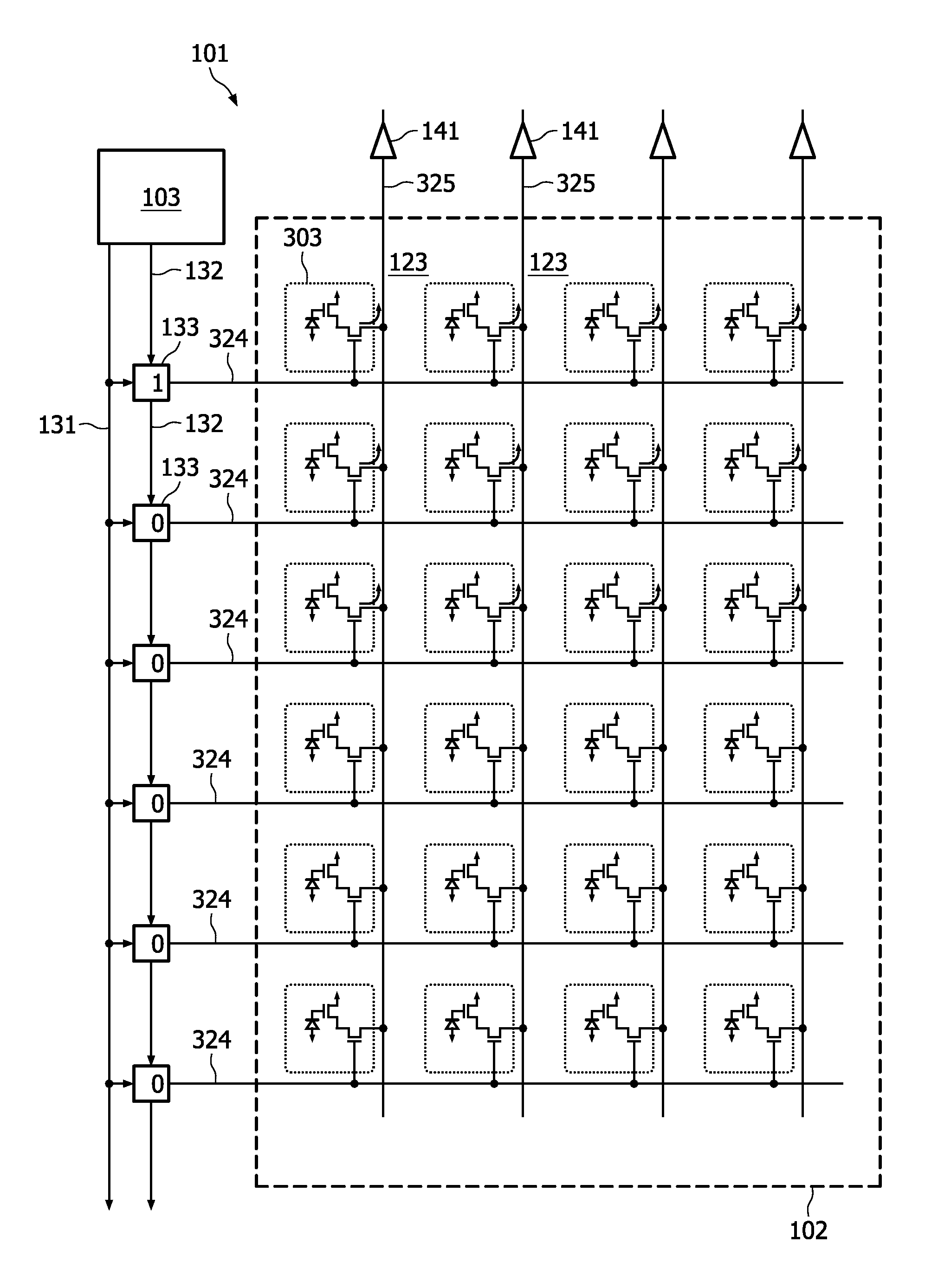Suppression of direct detection events in X-ray detectors
a detector and x-ray technology, applied in the field of detectors, can solve the problems of not all x-ray quanta are absorbed in the conversion layer, and substantially disturb the intended imag
- Summary
- Abstract
- Description
- Claims
- Application Information
AI Technical Summary
Benefits of technology
Problems solved by technology
Method used
Image
Examples
first embodiment
[0045] of the invention, e.g. two adjacent select lines (324) are activated at the same time and pairs of adjacent readout columns (325, 325) are connected by switches (142) between them. The further switches (142) are inactive. In this way, sets of four pixels are readout over the same column amplifiers (141) and the source terminals of the amplifier transistors are connected during readout. (Generally for arbitration according to the invention at least two pixels can be considered, preferably at least four are considered. A rectangular selection (e.g. all in 2 adjacent rows and all in 3 adjacent columns), of at least 1*2=2 pixels can be considered or a quadratic selection (e.g. all in 2 adjacent rows and all in (as many, i.e.) 2 adjacent columns) of at least 2*2=4 pixels can be considered.) In a normal image, all four pixels will have very similar brightness values. This leads to similar voltages on the photodiodes, resulting in similar gate source voltages in the four pixels and ...
second embodiment
[0047]the invention uses a more sophisticated pixel cell depicted in FIG. 4. This cell (303) contains also a photodiode (311), a reset switch (312), an amplifier transistor (313), a readout switch (314) and the associated control and readout lines (322), (324), (325).
[0048]In addition, it has a sample and hold circuit consisting of sample switch (315), sample capacitor (316) and buffer amplifier (317). Following the X-ray exposure, the signal from the photodiodes can be transferred to the sample capacitor (316) by activating the sample switches (315). The sampled signal can be read out via the buffer (317) and readout switch (314) independently from the next exposure on the photodiode (311). The sampling action is often referred to a synchronous shutter in the imager world.
[0049]Additional switches (352) and lines (351) allow connecting the sampling capacitors in horizontal direction under control of a not shown control circuit. Likewise, additional switches (353) and columns (354) ...
third embodiment
[0053]the invention is depicted in FIG. 6. Here a pixel (303) is subdivided into four sub-pixels each comprising a photodiode (311), an amplifier transistor (313) and a sample switch (315). A number of radiation collection devices, e.g. photodiodes (311) and amplifier transistors (313) connect via sample switches (315) to a common sample capacitor (316). A buffer (317) and readout switch (314) allow readout of the pixel.
[0054]Analogically to the previous embodiments, a sub-pixel affected by a parasitic direct detection event will have a lower gate potential than the other pixels, hence it will contribute less to the charging of the sample capacitor. Consequently, the signal from the parasitic direct detection event will be effectively suppressed.
[0055]A modification of this circuit uses only one sampling switch (315). Its left terminal is directly connected to the source terminals of all amplifier transistors in the pixel (no figure).
PUM
 Login to View More
Login to View More Abstract
Description
Claims
Application Information
 Login to View More
Login to View More - R&D
- Intellectual Property
- Life Sciences
- Materials
- Tech Scout
- Unparalleled Data Quality
- Higher Quality Content
- 60% Fewer Hallucinations
Browse by: Latest US Patents, China's latest patents, Technical Efficacy Thesaurus, Application Domain, Technology Topic, Popular Technical Reports.
© 2025 PatSnap. All rights reserved.Legal|Privacy policy|Modern Slavery Act Transparency Statement|Sitemap|About US| Contact US: help@patsnap.com



